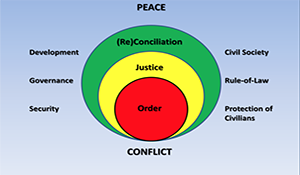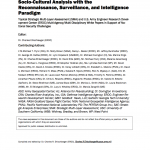Socio-Cultural Analysis with the ISR Paradigm

Socio-Cultural Analysis with the Reconnaisance, Surveillance, and Intelligence Paradigm.
Author | Editor: Ehlschlaeger, C. (ERDC).
Socio-Cultural Analysis (SCA) has evolved rapidly over the past decade as conflicts in Afghanistan and Iraq have forced the DOD to reappraise the techniques used to collect information about the populations in conflict zones. As these two major con- flicts wind down, the DOD must recognize that SCA must evolve again due the changing nature of phase zero operations and prepare for future conflicts. Given the challenges of declining DOD budgets while improving our SCA capabilities, the chap- ters in this white volume describe many of the issues facing the DOD for phase zero operations and collecting the socio-cultural information necessary should conflicts escalate. Most of the chapters’ discussions were heavily influenced by LTG Flynn et al.’s “Left of bang: The value of socio-cultural analysis in today’s environment” PRISM article.1 “Left of bang…” was also revised and included in the SMA/ERDC or- ganized White Volume “National Security Challenges: Insights from Social, Neurobi- ological, and Complexity Sciences.” SMA followed that effort with additional occa- sional white papers discussing the operational relevance of the social sciences2 and social science validity,3 available at http://www.nsiteam.com/publications.html. This White Volume builds on those efforts to provide a spectrum of views on the gaps on the operational use of SCA in a phase zero setting. If there is a valid criticism to be made regarding this white volume, it is that it favors researchers attempting to automate socio-cultural information processing over traditional qualitative techniques. The authors realize that the USG must understand socio-cultural situations across the entire planet to as high or higher level of fidelity than we did in Iraq and Afghani- stan: without spending equivalent resources. Collecting magnitudes more useful in- formation with a similar or smaller budget will require innovative techniques that don’t require socio-cultural experts hand massaging ALL the data into actionable information.
The chapters are organized from the more theoretical and philosophical to the more technical. The following brief description of these papers provides an overview of each chapter, but doesn’t express all the content contained within. The final chapter is an epilogue for both this White Volume and its sister tome: “Understanding Meg- acities with the Reconnaissance, Surveillance, and Intelligence Paradigm.”
In the first chapter, “Toward a New Strategy of Peace,” Christopher Holshek and Melanie Greenberg argue that the United States Government should refocus its phase zero strategic goals to more clearly emphasize “peace and security” over our “national security.” They discuss how civil-military capabilities, partner nations, and non-government organizations can improve socio-cultural systems to make peace more resilient as part of a larger, national strategic approach.
The next chapter, “The Use of Shared Socio-cultural Information and Research Vali- dation,” discusses recent social media projects in the DoD as well as potential South Asian social media projects and the constraints likely to be seen in Bangladesh. Dr. Laura Steckman presents this view, both as a researcher and as a COCOM analyst. Chapters Eight and Eleven also focus on socio-cultural analysis using media data.
In Elizabeth Malone and Richard Moss’s Chapter Three, “Measuring Vulnerability to Climate Change: An Indicators Approach,” important natural indicators are modeled decades into the future. In a phase zero stability and security planning environment, forecasting indicators is critical to preparing plans that will take years to implement. While social indicator forecasting’s accuracy will degrade much more quickly than natural indicators, the techniques discussed in this chapter apply to modeling social indicators.
Dr. Palmer-Moloney et al.’s “Urban-Rural Dynamics and Regional Water Security” chapter presents the complex relationship between natural (water) resources, so- cial factors, state & sub-state stability, and security challenges. The chapter presents these relationships in an in-depth analysis of the Helmand River Basin.
In Chapter Five, “Through the Eyes of the Population: Establishing the SCA Baseline for RSI,” Dr. David Ellis and James Sisco expand on their earlier writings about the Reconnaissance, Surveillance, and Intelligence (RSI) paradigm. The chapter intro- duces a methodology they call the “Five Foundations of SCA.” It concludes with a case study on Syria illustrating how RSI with a rich SCA baseline using the “Five Foundations” methodology could have greatly enhanced the analysis of and policy responses to achieve US policy objectives in Syria.
Dr. Jonathan Pfautz & Mr. David Koelle, in Chapter Six “Approaches to Addressing Challenges in the Operational Use and Validation of Sociocultural Techniques, Tools, and Models” explore the challenges in creating computational models to support operational missions. They also present several approaches to ensuring operational validity of social science results.
Dr. Lynn Copeland, Lynndee Kemmet, Jeffrey Burkhalter, Marina Drigo, & Dr. Charles Ehlschlaeger discuss the potential contribution of tactical forces to strategic and operational planning in an RSI environment in Chapter Seven, “The Who, What, Where, and How of Regionally Aligned Forces: Supporting COCOM Mission Plan- ning.” While current DoD tactical phase 0 stability operations are spread throughout multiple organizations, information techniques are being standardized across these organizations. These teams are also increasingly operating within Combatant Com- mands (COCOMs) as envisioned in the Regionally Aligned Forces (RAF) concept. This chapter discusses challenges for improved data collection, the development of metrics, and phases zero information sharing.
In Chapter Eight, “Sentiment & Discourse Analysis: Theory, Extraction, and Applica- tion,” Drs. Steve Shellman, Michael Covington, and Marcia Zangrilli discuss automat- ed sentiment discourse from newly developed automated sentiment and discourse software engines. The chapter concludes with a study that uses automated infor- mation to explain and forecast the violent behavior of groups. Chapters Two and Eleven also discusses media analysis issues.
In Chapter Nine, “Integrating Social Science Knowledge into RSI,” Hargrave et al. dis- cuss a novel approach to making social science literature more easily accessible to analysts in the operational environment. The chapter includes a notional case study on the topic of insurgency in an African nation.
Chapter Ten, “Automating Early Warning of Food Security Crises,” by Dr. Molly Brown explores how a food insecurity early warning system could be automated and assessed remotely. The chapter draws from her experience working with the Famine Early Warning Systems Network (FEWS).
In “Identifying and Understanding Trust Relationships in Social Media,” Chapter Eleven, Corey Lofdahl, Jonathan Pfautz, Michael Farry, & Eli Stickgold discusses how Twitter data can be used represent four metrics that identify information-based trust relationships for potential use in phase zero planning and situation awareness. The chapter complements other media analysis research in Chapters Two & Eight.
Finally, Drs. Valerie Sitterle and Charles Ehlschlaeger will summarize the research presented in this white volume as well as the research in the Understanding Megaci- ties with the RSI Paradigm white volume as they relate to phase 0 operational de- sign and planning. This epilogue will draw heavily on “lessons learned” while per- forming research for the OSD sponsored Megacities-RSI project at ERDC.
Contributing Authors
LTG Michael T. Flynn (DIA), Dr. Molly Brown (NASA), Carey L. Baxter (ERDC), Mr. Jeffrey Burkhalter (ERDC), Dr. George W. Calfas (ERDC), Dr. Lynn Copeland (USASOC), Dr. Michael Covington (CI), Ms. Marina Drigo (PG), Dr. Charles Ehlschlaeger (ERDC), Dr. David Ellis (GBH), Mr. Michael Farry (CRA), Melanie Greenberg (AL), Dr. Michael L. Hargrave (ERDC), Christopher Holshek (AL), Ms. Lynndee Kemmet (WP), Mr. David Koelle (CRA), Dr. David A. Krooks (ERDC), Dr. Corey Lofdahl (CRA), Dr. Elizabeth L. Malone (PNNL), Dr. Dawn A. Morrison (ERDC), Richard H. Moss (PNNL), Natalie R. Myers (ERDC), Rick N. Myskey Jr. (AGC), Eric M. Nielsen (ERDC) SFC (ret), Dr. Laura Jean Palmer-Moloney (ERDC & NGA), Timothy K. Perkins (ERDC), Dr. Jonathan Pfautz (CRA), Dr. Chris C. Rewerts (ERDC), Angela M. Rhodes (ERDC), Dr. Valerie B. Sitterle (GaTech), Dr. Steve Shellman (SAE), James Sisco (GBH), Dr. Monica L. Smith (NGA), Dr. Laura Steckman (WBB), Mr. Eli Stickgold (CRA), Dr. Lucy A. Whalley (ERDC), Dr. Marcia Zangrilli (SAE)

Comments